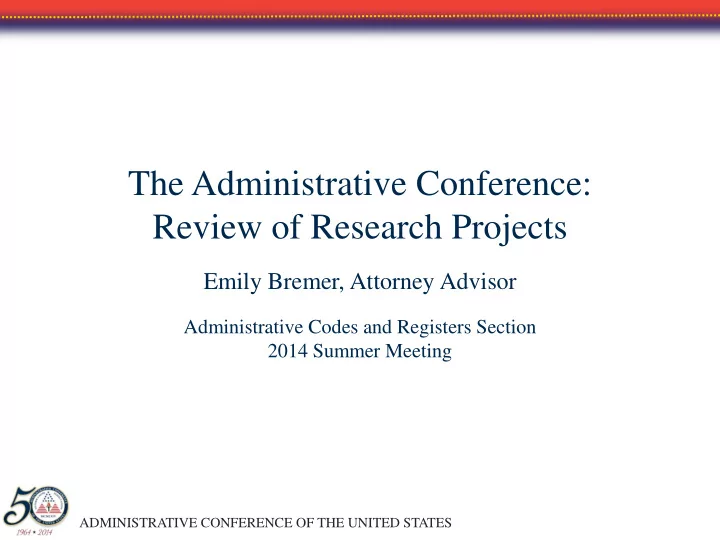

The Administrative Conference: Review of Research Projects Emily Bremer, Attorney Advisor Administrative Codes and Registers Section 2014 Summer Meeting ADMINISTRATIVE CONFERENCE OF THE UNITED STATES
The Administrative Conference “is a public -private partnership designed to make government work better.” President Barack Obama July 8, 2010 2
ACUS Overview • The Conference is an independent agency in the executive branch. • 101 voting members, including: • Chairman: Appointed by the President and confirmed by the Senate. • Council: 10 members, split between public and private; appointed by President. • Government Members: 50 high-ranking agency officials. • Public Members: 40 individuals from the private sector, including academics, private practitioners, and experts working for non-profit organizations; politically balanced. • Non-voting members include: • Liaison Representatives: other agencies and professional associations (e.g., ABA). • Senior Fellows: previous members, including three Supreme Court Justices. 3
The Research Process • Members are divided into six committees. • Each has a different subject matter focus: • Adjudication, Administration & Management, Collaborative Governance, Judicial Review, Regulation, and Rulemaking. • Independent research conducted by consultants or in-house researchers. • Recommendations crafted in open committee meetings and adopted by vote of the full Assembly of the Conference at semi-annual plenary sessions held in June and December. 4
Recommendations • The Conference typically issues 8-10 recommendations per year. • Conference recommendations can be directed to: • Congress, urging it to create, amend, or repeal statutes; • The Executive Branch, including agencies and the White House; and • The Judiciary, through the Judicial Conference. 5
E-Rulemaking Recommendations • The Conference was de-funded in 1995, just as electronic communications were coming into use. • Since 2010 re-birth, many of our projects have focused on the new realities agencies face as a result of these technologies. • Several recent recommendations have contributed incrementally to a body of work addressing these new realities: • Recommendation 2011-1, Legal Considerations in e-Rulemaking • Recommendation 2011-2, Rulemaking Comments • Recommendation 2011-8, Agency Innovations in e-Rulemaking • Recommendation 2013-5, Social Media in Rulemaking
Social Media in Rulemaking • Expected “revolution” in rulemaking— hope for a more dialogic process — but process has remained largely recognizable, even as it has moved from a paper process to an electronic process. • Social media holds obvious potential for fulfilling the hopes of e- Rulemaking. • Issues related to the use of social media in rulemaking were raised in Committee on Rulemaking’s deliberations on previous e -Rulemaking recommendations. • But these issues were beyond the scope of those projects and deserved careful study.
Purpose and Goals of the Study • “Social media” defined as “any online tool that facilitates two -way communication, collaboration, interaction, or sharing between agencies and the public.” • Federal government use of social media is significant, but largely related to non-rulemaking activities. • Non-use of social media in the rulemaking context apparently attributable to legal uncertainty and policy considerations. • Goal is to establish a framework for experimentation, with understanding that further examination will likely be required.
Research • Consultant: Professor Michael Eric Herz of Cardozo School of Law. • Research included workshop co-sponsored with the GWU Regulatory Studies Center and use of third-party facilitator for online discussion. • Few available case studies: • Department of Transportation’s work with Cornell eRulemaking Initiative (CeRI). • Federal Communications Commission • Consumer Financial Protection Bureau
Recommendation 2013-5 • Adopted on December 5, 2013. • Recommendation takes a tone of cautious optimism. • Recognizes that social media may bring benefits, but not in all rulemakings. • Pre-rulemaking stage (i.e., before a Notice of Proposed Rulemaking (NPRM) is issued) and retrospective review may be ideal times for experimentation. • Acknowledges costs. • “Social media” must be disaggregated: it consists of a set of tools that will evolve and change over time.
Recommendation 2013-5 • Addresses: • Opportunities to improve public outreach; • Importance of thoughtful planning; • Necessity of explaining to the public how a social media discussion will be considered; • Special considerations related to particular types of social media tools; and • Legal considerations.
Recent Recommendations • Recommendation 2014-1, Reducing FOIA Litigation Through Targeted ADR Strategies. • Recommendation 2014-2, Government in the Sunshine Act. • Recommendation 2014-3, Examining the Guidance Function of Agency Preambles. • Recommendation 2014-4, Ex Parte Communications in Informal Rulemaking. • These four recommendations were published at 79 Fed. Reg. 35,993 (June 25, 2014), and are also available at www.acus.gov. 12
Current ACUS Projects (Selected) • Retrospective Review of Agency Rules. • Petitions for Rulemaking. • Best Practices for Using Video Teleconferencing for Hearings and Related Proceedings. • Federal Administrative Adjudication. 13
Thank you! • Information on these and all our other projects available at www.acus.gov. • Please contact me at ebremer@acus.gov or 202.480.2086.
Recommend
More recommend